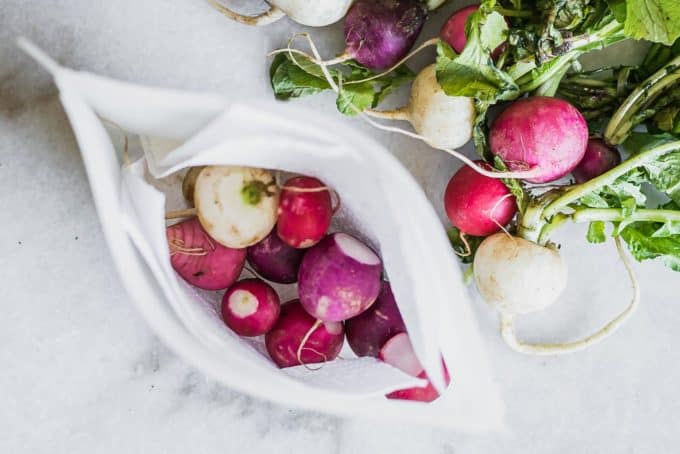Most individuals who want to lead healthier and fitter lives will come to know that getting our recommended daily intake of vegetables is part of the solution. Radishes are very versatile when it comes to cooking and consuming in the kitchen to help set up the nutrient qualities and enhance flavor when taken.
Sadly, one may find it quite challenging to preserve Radishes for a considerable period to have the crispy texture. That is why this article explains how to ‘lay down’ radishes and the virtues to savor radishes in your meals.
Let’s get started!
1. How to Store Radishes at Room Temperature
Without a refrigerator, you might have to store food at room temperature. This means that you’ll need to find a creative way to keep the radishes fresh. So, here’s a way you can store radishes at room temperature using a bowl and some water for up to 3 days.
- Take a bowl that is wide enough to hold the radishes you want. Then, take your unwashed radishes and arrange them inside the bowl. You’ll need to place them upright so that the leaves stand out of the water.
- Add cold water to the bowl to the point where it partly covers the bulbs for about an inch or two without reaching the leaves. You should change out the water every day and constantly watch the stems for drooping since it could serve as an indication of the radishes dying. If the leaves start to lose their shape, you should know the bulb will follow shortly.
- If you suspect that you can no longer keep them fresh, you should wash them and slice them up or use them in a recipe. To ensure they last longer, you might want to put the radishes in the fridge, which will keep them in good condition for about a week.
2. How to Store Radishes in the Fridge with a Jar
Another method you can use to store radish is placing them inside a mason jar and storing them in the fridge. You can use this strategy to keep them crisp and fresh for up to 10 days, and you can alternatively use a pickle jar if you don’t have a mason jar available.
- Start by washing the radishes and removing the dirt using a brush since you don’t want to store them unwashed.
- Then, take a chopping board and cut the greens and roots of the radishes using a sharp knife.
- Place the radishes inside the jar that can fit them without difficulties and fill it with cold water to ensure they are completely submerged.
- Seal the lid tight and tip over the jar to ensure it doesn’t leak any water. This storage method can preserve the freshness of your vegetables but, you’ll need to feel them every so often to ensure they don’t get too soft. If they lose their firm texture, you’ll want to use them in your salad as soon as possible.
3. How to Store Radishes in the Fridge with a Plastic Bag
For this radish storage method, you’ll need a plastic bag, some paper towels, and a refrigerator. You can use this technique to keep the radishes for two weeks.
- Begin by cutting off the tops of your radishes which involves removing the leaves and roots. Keeping them unwashed can help extend their preservation until the day you want to eat them.
- Next, you should take the paper towel and sprinkle some water on it to make it moist. Pat the water into the towel with clean hands to ensure you wet every part well. Insert the damp paper towel into the plastic bag and use it to line the inside. The moisture in the towels will provide the humidity the radish needs to stay fresh.
- Arrange the radishes in the bag and ensure they are positioned between the paper towel so that they are covered from each side.
- Finally, press the plastic bag firmly to remove the excess air before you seal it shut and put it in the crisper drawer where the radishes can stay fresh for 2 weeks.
4. How to Store Radishes in the Basement
If you don’t use your basement for a specific function, a simple way to put it to work is to store your radishes there. This is because the basement resembles the dark, cool environment where the radishes grow in the soil. So there’s no need to exhaust the room in your fridge if you have a basement or cellar.
- Take an old box and fill it with damp dirt. If the soil from your garden is dry, you should spray water on it to make it moist without soaking it.
- Then, place the radishes one by one into the dirt as if you are planting them. As you do so, ensure there isn’t any contact between the leaves or stems because if any radish starts to rot, it’ll spread through the roots and affect the entire batch.
- From there, you can harvest your radishes according to your needs. Remember to wash the radishes before you use them in your meals. As long as your cellar is devoid of light and heat, your radishes can last as long as three months without going bad.
This, perhaps, could be ranked as a better form of preserving radish than storing them in refrigerator as one can keep them for months rather than weeks. Whenever the soil gets very dry, it is recommended to sprinkle some water on the soil for enhancing the moisture of storage of radish. You also need to label a box in which you put the freshly laid radishes to avoid forgetting the right time for consuming this vegetable.
5. How to Properly Freeze Radishes
Sometimes, you might have a lot of radishes that you can’t consume even within several weeks. In such a case, freezing can be a suitable method of preserving them. Unfortunately, the vitamins and minerals we get from radishes are only available while fresh and whole. So, while freezing them will lengthen their shelf life, radishes will lose their crunchiness and nutrition as they sit in your freezer.
Here are the steps to follow when freezing radishes;
- Brush the dirt off your harvested vegetables and wash them with some cold water by running them under your faucet.
- Then, cut the stems and the root ends while ensuring you remove all the blemishes that you can see on the skin. However, don’t peel off the radish since the skin offers protection that assists in preservation.
- The next step is to slice the radishes in half or quarters, depending on the size. The reason you should cut the radish is that if you store them whole in the freezer, they will ultimately crack.
- Boil some water and place the radishes inside for about 3 minutes to drag the ripening process down so that the vegetables don’t become soft as quickly. This step, known as blanching, will help the radishes retain their bright color as they sit in the fridge.
- After boiling them, you should stop the cooking process by placing them into a bowl of cold water. Once cool, drain the water and wait a little bit to let the radishes dry.
- Finally, place them in freezer bags and squeeze out as much air as you can while taking note of the date you stored them.
6. How to Store Radish Greens
Most people unknowingly discard radish greens without wondering whether they can be useful in the kitchen. Fortunately, the greens are also edible and can add taste and nutrition to your meal when properly used. The leaves and stems of radish get water and minerals from the bulb, which is why they don’t last long after you cut them off. Nevertheless, here’s how you can store the greens;
- Chop off the greens and place them inside a plastic bag while unwashed.
- Press out all the air from the bag to create a suitable environment for preserving your greens.
- Place the greens inside the crisper drawer in your fridge and ensure you cook or use them for a fresh salad within 3 days.
How Can You Tell When Radishes Are Going Bad?
Like other vegetables, radishes are perishable, which is why you should assess them before cooking or eating them. Whether you have just harvested them or have stored them for a while, you should inspect them to ensure they are safe for consumption.
Radishes that have exhausted their moisture content aren’t of much worth to the taste of your food or health. As such, you want to avoid eating dry radishes or those that have turned dark. If you notice any spots on the radish, just remove them to ensure the vegetable is in good shape underneath.
Nevertheless, there are some signs that can tell you if the radishes are bad, including;
1. Soft Texture
Healthy radishes should have a firm, crispy feel. If the radish is soft to the touch, it means that they are spoilt. However, if you had frozen your radish, they can feel soft after defrosting them, which isn’t an indication that they’ve gone bad.
2. Foul Smell
Fresh radishes don’t have a specific smell which is why a bad smell is an indication that the produce is not safe to eat. When they start to rot, radishes release a pungent odor that will discourage you from consuming them. If you notice this smell, you should throw the radishes away.
3. Appearance
Radishes should host a bright red color that shows their freshness. As the radishes lose their viability, they become pale or dull. If you notice a serious color change in the appearance of the radish, they might not be ideal for eating. Additionally, they could grow mold which is another red flag.
What are the Benefits of Radish?
1. Improved Blood-Oxygen Levels
Radish contains compounds that can reduce red blood cell damage. As a result, eating radish can improve the amount of oxygen your blood can transport as the number of red blood cells increases.
2. Fiber
It is also very efficient and healthy to add radish into your diet regularly because of the high fiber and roughage that is incorporated into it. It can also help to promote better digestion, regulate the amount of bile and therefore reduce the risk of liver damage. In light of this, it is unclear how a little more of fiber can be considered a problem for your body.
3. Heart Safety
Radishes also contain essential vitamins required to maintain an ideal heart health they are also contain anthocyanins. This means that if you want to be protected from developing the cardiovascular diseases then you should try taking foods like radishes.
4. Manages Blood Pressure
Another mineral that radishes can provide is potassium which is useful in controlling high blood pressure. So, if you suffer from hypertension, a strategy you can adopt to manage your blood pressure is incorporating more radishes in your meals.
5. Better Immunity
In addition, it is the good source of vitamin C which is nutrient that is used for enhancing the immune system. Eating radish often could bring you the boost which is capable of protecting you against colds and coughs due to a boosted immunity system against infections. Furthermore, it has abilities to combat formation of dangerous free radicals, inflammation and aging for want of vitamin C.
6. Hydration
The bulbs of radishes mostly comprise water which is why eating radishes is one way of indirectly hydrating. If you are looking to increase your water intake, you can do so by including water-rich vegetables like radishes in your meals.
7. Fortification of Blood Vessels
Collagen is needed in our bodies because it is used in clotting and to reinforce blood vessels, making the production of this compound central to our well-being. Blood vessels are important because they are responsible for the different functions of the body thus health blood vessels facilitate smooth flow of oxygen or nutrients in the body. Food such as radishes can influence more collagen formation which can reduce the chances of suffering from diseases such as atherosclerosis.
8. Skin Health
It is also notable that consuming radishes can help ameliorate the texture and quality of your skin, due to the vitamins C, phosphorus as well as zinc. These nutrients can help to help make the skin flexible, to clear skin break outs, and to keep skin rashes at bay.
On the same note, preparation from mature radish that is ground into paste may be used as a formula to treat dandruff, strengthen one’s hair and prevent hair fall.
Conclusion
This article gives different tips on how to store the vegetables in the best way by giving it special attention to radish. That means you do not have to spend a lot of money for equipment or go to absurd lengths to ensure these vegetables will be ready for human consumption. Some of the pre-requisites that can be easily found are; plastic bags, paper towels, cold water, soil and a fridge; you can be able to store them for weeks until when you intentions of using the radishes are ready.














